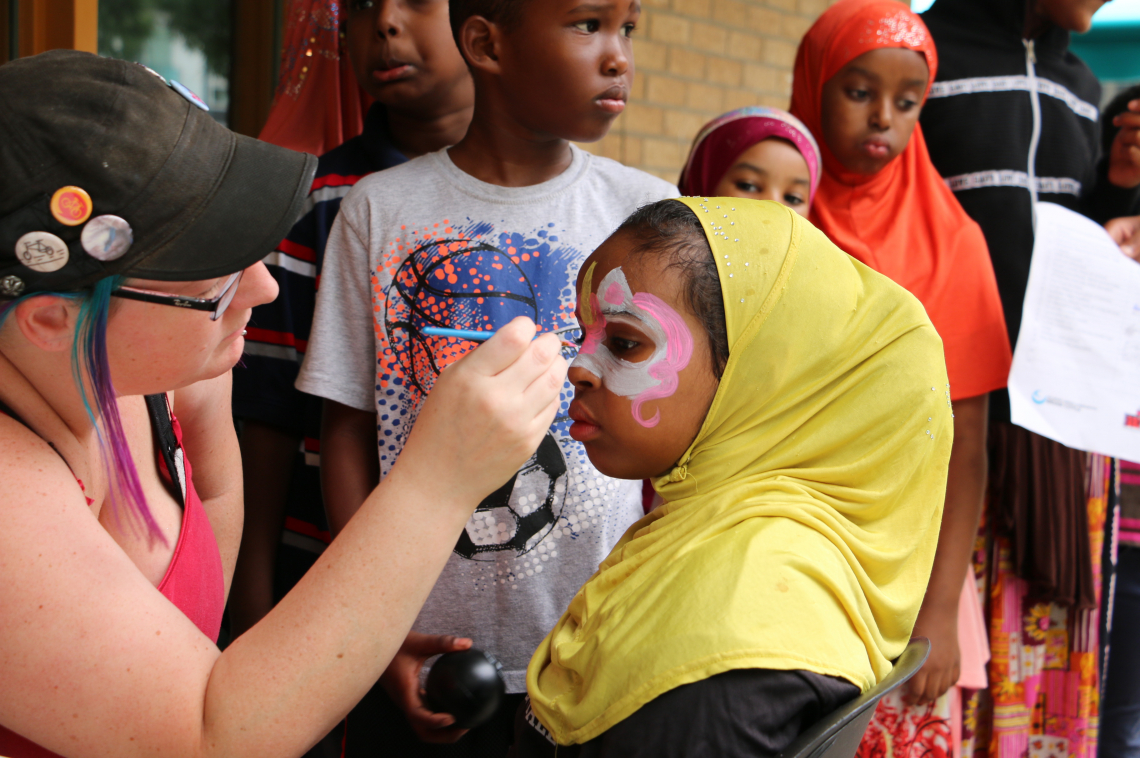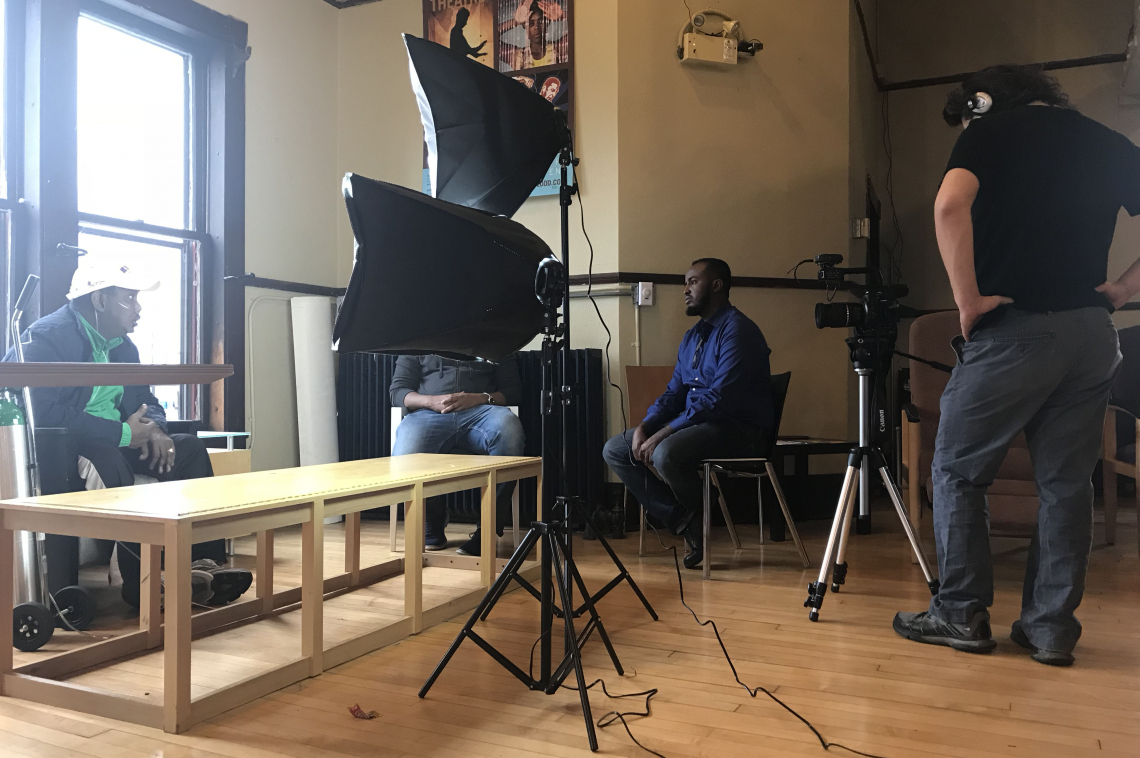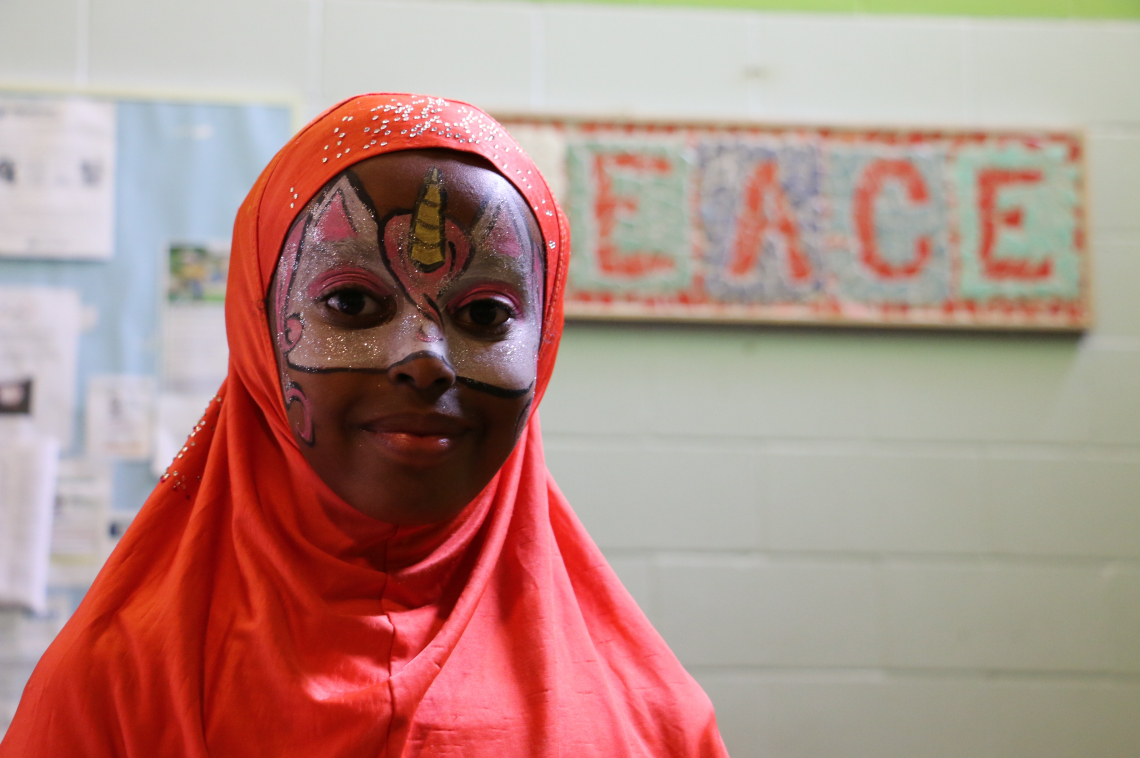


Minneapolis’s Mixed Blood Theatre “changes attitudes, behavior, and policy by paying positive attention to difference.” Since their founding in 1976, the organization has been based in the city’s Cedar-Riverside neighborhood: a “naturally occurring cultural district” that is home to over 4,000 people from 67 countries who speak at least 93 languages, a majority of whom are originally from East African, Muslim, and Hmong communities.
In 2016, Mixed Blood received a grant from ArtPlace to support their project “154: Profiles of Health & Belonging,” which sought to position the theater as “unifier of a cohort of community organizations, resident-led coalitions, a community clinic, managed health providers, and theatre artists, to explore the intersection of traditional medicine and public health.”
In November 2018, ArtPlace caught up with the project’s coordinator, Abdurrahman (Abdu) Mahmud, and the theater’s chief engagement officer, Keri Clifton, to ask how it’s been going. In a nutshell: many lessons have been learned and adjustments have been made; “Story Circles” and video profiles have emerged as two of the most interesting and successful methods of understanding local needs and connecting members of the community; and this summer, an “artistic response” in the form of a storytelling festival will amplify some of the project’s key takeaways and show the whole city what these past three years of work have been about.
ArtPlace: The objectives of Mixed Blood’s ArtPlace grant—and the methods proposed for achieving them—were pretty wide-ranging. Two-plus years in, what activities, events, or approaches are becoming the cornerstones of the “154” project? Why do you think these particular initiatives have been successful? What hasn’t worked as well?
Keri: “154” was really ambitious in trying to change people’s healthcare outcomes, but early on, we came to the realization that we’re not actually able to track those outcomes very well. So we decided to focus the work more intentionally on building community and trust, and on getting residents to connect with other residents, and healthcare providers to connect with other providers. The need for resources in Cedar-Riverside is very real, and there are many barriers to connecting with the healthcare system here. We see ourselves as the middle ground. We’ve now decided to focus on just 20 people, captured in short video profiles. We’ve shot six films so far and are in the process of editing them.
Last year, with Abdu’s leadership, we started our twice-monthly Story Circles series, which connects groups of men and groups of women to help them talk with each other and to help us learn about their needs and experiences. Sometimes the events work really well, and sometimes they don’t. There are challenges, like getting residents to appear on film—we haven’t gotten any women to volunteer so far; only men. There are trust issues around where the video might be shown or how they might be seen. Even some men have come back to us and said, “We’re not sure we actually want to be featured…” We’d like for the people we profile in the videos to come through Story Circles, since that’s better for our evaluation methods. But if we can’t find enough people that way—particularly women—we’ll look to other ways.
To build trust with residents, we want to prioritize sitting alongside them and considering their needs over ours. I’m thankful to have Abdu as a guide for that. He does a lot of listening, which is so important; it allows us to know where to go.
We’re also planning an artistic response to this work. It’s not completely mapped out yet, but we’re planning for it to be a storytelling festival, in summer 2019—probably June.
Abdu: When I joined Mixed Blood and went out into the community asking people to come to Story Circles, people in this neighborhood knew me as Abdu, but they didn’t have full trust in what I was asking. They had a lot of questions: “What will you do with this information?” “Will my relative know that I said this personal thing about him?” “Do you want to use my full name?” There is no anonymity in this neighborhood; each one knows the other one! But now, people don’t ask me those things; in the past year, I’ve become the trusted guy.
At this point, we feel like all the Somali folk know [about Mixed Blood’s health work], but there are also Korean people in the community, African American people… So we need to focus on other communities now. In our remaining Story Circles—I think we have 14 left to go—we’ll have other strategies to go into these other communities, and we’ll focus on some different issues. We need new faces to be part of the project.
ArtPlace: Can you tell me about your health fairs, too?
Keri: Our first fair happened in 2017 in partnership with People’s Center. It was focused on women; we had mammograms on site. It wasn’t as well-attended as we would have liked. The second fair was held in conjunction with the Brian Coyle Center, and it was more general: we had food giveaways, a DJ... Hundreds of people came, and it was a great opportunity for them to connect to local resources. In April 2019, we’re planning to host another fair just by ourselves and simply promote the resources we know about. We think that’s probably the best way we can address direct service needs. We’re not a social service agency, so we need to operate within our role and our capacity.
ArtPlace: Can you go into more detail about the Story Circles? What are they like?
Abdu: In the twelve Story Circles we’ve done so far, the average attendance has been seven people; the max we allow is ten. We typically separate them by gender because we’ve found women aren’t as comfortable speaking in front of men from the neighborhood. Though sometimes when we’re meeting with younger people or professional women, it can be more mixed.
So far, people have told us about the service gaps they find and the challenges they meet when going to providers in the neighborhood. We’ve found there have been high expectations from residents that we’ll be able to provide a solution—and we need to distance ourselves from that! We need to communicate effectively about what we can do and can’t do. People say, “I don’t have insurance—can you help me?” Or, “I have this health problem, I’ve been seeing a doctor, but nothing is helping, can you help?” Or, “I had this bad experience with my doctor, can you talk to them?” People see us like we have all the resources to bring the solution, but we don’t. So that’s the biggest lesson we’ve learned so far.
Also, people in this neighborhood are good storytellers—that’s part of the reason behind the festival. They have the skills; we can give them the platform to be part of something great. We’re trying to bring something they can be part of, where they can say: “I belong to this,” and they can feel we are sending their message to places they cannot reach on a daily basis. Hopefully, they’ll see how sharing their experience with us can help them build their story—which is something they can always have and use.
The most challenging part is getting people to commit to coming and sharing. Many people don’t have time to attend an hour and a half session, and many are not comfortable sharing their personal stories. For example, folks who used to live in refugee camps, where they feared for their lives, they don’t always feel they can share that—with us or even with their doctors. Also, when people come and share a very bad experience, sometimes they give us a false name or phone number, because they have a fear of the system.
The Circles show how different people’s experiences can be. If you don’t speak English, or if you’re not used to saying “no” to the government and you think the healthcare facility’s interpreter is the government... All kinds of misunderstandings can occur. But some people have shared a lot—good outcomes as well as bad ones. We take a lot from every Circle, and it will all be helpful for our artistic response. A lot of people have had experiences that they never had the opportunity to speak about before.
In our last Circle, we asked people about the way forward: what they wish to see in the neighborhood. That’s another good thing. We’re also thinking about organizing a meeting of neighborhood leaders, sharing with them what we’ve learned so far, and asking their opinions. One challenge there is that there are a lot of local “activists,” but they will only tell you the objectives of their organization or their political affiliation. Finding out people’s real, personal opinions can be harder.
Keri: Prior to Abdu joining Mixed Blood, the Story Circles were led by a medical professional who did much speaking about health in English, with an interpreter. It felt much more like a focus group, and that we were telling, not having the community connect with each other. It helps make the event more about connection and shared benefit when it’s held in Somali. That makes it makes it harder for me!, but sometimes I can still see people’s emotions.
Abdu: The other thing we do now is go around the neighborhood. Initially our plan was just to bring people to Mixed Blood for Story Circles, but then we realized they’re not necessarily comfortable here. They have to commit to going someplace, and it feels like an official discussion, where they need permission; sometimes their guard never goes down. So now what we’re trying is going to their spaces: a restaurant, a coffee shop, the mall, the madrassa—where they already go to talk about these issues—and we just join them there. I learned that people talk a lot more in those places, and speak freely. Although, we do want people to keep coming back to Mixed Blood to become familiar with this space, too.
ArtPlace: Have you heard any particularly memorable stories in Story Circles that you’d like to share with ArtPlace readers?
Keri: There was one woman who had several children but had also had several miscarriages. She had some health problems associated with her fertility. When she was pregnant with her last child, her doctor told her she should get her tubes tied, because another pregnancy could be a risk to her life. She had to discuss it with her husband... I just remember feeling the loss she felt when she decided to get her tubes tied and she lost some sense of her womanhood and, with that, some sense of herself. All the other women in the Circle were sitting near her, with her. And I happened to be pregnant myself at the time! It was such an impactful moment for me to witness this coming together of community: even though I didn’t have the language, I felt so connected to her. The baby I gave birth to after that was my last baby, so even though I didn’t have a similar health problem to contend with, all the things that story meant about fertility and being a mother were right there; very present for all of us.
***
Abdu, Keri, and their colleagues at Mixed Blood are “thinking critically” about how to keep their “Profiles of Health” work going in the future. “Health is life, and everything in life can impact health. So this project could grow to be increasingly broad-based,” Keri says.
In addition to their summer storytelling festival, Mixed Blood also plans to publish some final reports based on their Story Circles and host a presentation of their project findings this year. Check their website for updates.
Read more about Mixed Blood’s health fairs in Broadway World.
See a bilingual (Somali-English) video promo the theater produced for one of their health fairs.
Read more about “154” in Minnesota Daily.





